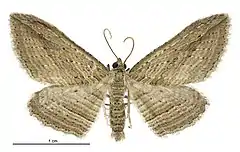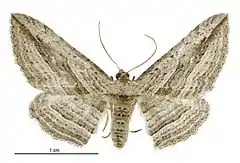Austrocidaria arenosa
Austrocidaria arenosa is a species of moth in the family Geometridae. It is endemic to New Zealand. This moth is classified as "At Risk, Declining" by the Department of Conservation.
| Austrocidaria arenosa | |
|---|---|
 | |
| Male | |
 | |
| Female | |
| Scientific classification | |
| Kingdom: | |
| Phylum: | |
| Class: | |
| Order: | |
| Family: | |
| Tribe: | |
| Genus: | |
| Species: | A. arenosa |
| Binomial name | |
| Austrocidaria arenosa | |
| Synonyms[2] | |
| |
Taxonomy
This species was first described by George Howes in 1911 using specimens collected at Mr O'Connors house at Titahi Bay, Porirua and given the name Eucymatoge arenosus.[3] George Vernon Hudson discussed and illustrated this species in his 1928 publication.[4] Hudson changed its epithet to arenosa.[4] In 1988 John S. Dugdale discussed this change and assigned the species to a new genus Austrocidaria.[2] The holotype specimen is held at the Natural History Museum, London.[2]
Description
Howes described the adult moths of the species as follows:
Male and female, 26 lines. Head and thorax whitish-ochre, slightly touched with grey. Abdomen whitish-ochre with black bar interrupted in centre on apex of all segments. All wings whitish-ochreous, crossed by waved darker striae. A slight darker suffusion from apex towards centre of forewing. Cilia greyish-white, with a darker-grey line at base. A series of minute black marks along veins and around termen.[3]
Distribution
This species is endemic to New Zealand.[1][5] As well as the type locality of Titahi Bay, A. arenosa has also been recorded as occurring at Moeraki near Oamaru,[4] at Paekākāriki,[6] and near Cass.[7]
Biology and life cycle
This species is attracted to blossoms, sugar and light.[3] Adult moths are on the wing between November and March.[3]
Conservation status
This moth is classified under the New Zealand Threat Classification system as being "At Risk, Declining".[8]
References
- Gordon, Dennis P., ed. (2010). New Zealand Inventory of Biodiversity. Volume two. Kingdom Animalia: Chaetognatha, Ecdysozoa, Ichnofossils. Vol. 2. Christchurch, N.Z.: Canterbury University Press. p. 459. ISBN 9781877257933. OCLC 973607714.
- Dugdale, J. S. (1988). "Lepidoptera - annotated catalogue, and keys to family-group taxa" (PDF). Fauna of New Zealand. 14: 175. Archived from the original (PDF) on 27 January 2019. Retrieved 8 May 2018.
- Howes, G. (1911). "New species of Lepidoptera". Transactions and Proceedings of the New Zealand Institute. 43: 127–128 – via Biodiversity Heritage Library.
- Hudson, G. V. (1928). The Butterflies and Moths of New Zealand. Wellington: Ferguson & Osborn Ltd. p. 97.
- "Austrocidaria arenosa (Howes, 1911)". www.nzor.org.nz. Landcare Research New Zealand Ltd. Retrieved 2018-05-08.
- Hudson, George Vernon (1939). A supplement to the butterflies and moths of New Zealand. Wellington: Ferguson & Osborn. p. 405. OCLC 9742724.
- White, E.G. (1991). "The changing abundance of moths in a tussock grassland, 1962-1989, and 50-to 70-years trends" (PDF). New Zealand Journal of Ecology. 1991: 5–22.
- Hoare, R.J.B.; Dugdale, J.S.; Edwards, E.D.; Gibbs, G.W.; Patrick, B.H.; Hitchmough, R.A.; Rolfe, J.R. (2017). Conservation status of New Zealand butterflies and moths (Lepidoptera), 2015 (PDF). Wellington, New Zealand: New Zealand Department of Conservation. p. 7. ISBN 9781988514383.